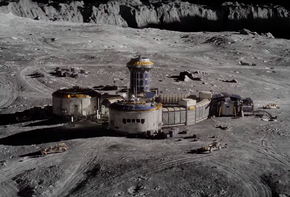Haller Base: Difference between revisions
No edit summary |
No edit summary |
||
| Line 6: | Line 6: | ||
| settlement_type = {{wp|Moon|Lunar}} {{wp|Exploration of the Moon|research station}} | | settlement_type = {{wp|Moon|Lunar}} {{wp|Exploration of the Moon|research station}} | ||
| image_skyline = Haller Base facilities on the surface.png | | image_skyline = Haller Base facilities on the surface.png | ||
| imagesize = | | imagesize = 290 | ||
| image_caption = Haller Base facilities on the surface in 2008 | | image_caption = Haller Base facilities on the surface in 2008 | ||
| image_flag = | | image_flag = | ||
Revision as of 19:21, 28 December 2020
This article is incomplete because it is pending further input from participants, or it is a work-in-progress by one author. Please comment on this article's talk page to share your input, comments and questions. Note: To contribute to this article, you may need to seek help from the author(s) of this page. |
Haller Base Station | |
|---|---|
 Haller Base facilities on the surface in 2008 | |
| File:Location of Haller Base.png | |
| Sovereign state | |
| Location on Luna | Jenssen crater, Soguichi Plateau |
| Administered by | Lunar Exploration Initiative of the MAOA and Air Force |
| Established | 9 November 1987 |
| Retired | 15 February 2009 |
| Named for | Emil G. Haller |
| Population (1987 / 2008) | |
| • Total | 5 / 22 |
| Type of operation | |
| • Crew | All year-round |
| Operation | |
| • Status | Inoperational |
| Dimensions |
|
| Facilities | 6 buildings and facilities:
|
The Haller Base Station (Hesurian: Haller-Basis-Forschungsstation) is the Mascyllary research station in the Jenssen crater of the Soguichi Plateau on the surface of Luna, the second planet of the world's binary planet system. It was operated under the Lunar Exploration Initiative (MLEI) jointly of the MAOA and Air Force from 1987 to 2009 and is considered to be the furthermost point of Mascyllary jurisdiction and only one on Luna. The base is named in honour of rocketry pioneer and polar explorer Emil Haller who was a significant contributor to the foundation of the MAOA and its early human spaceflight projects.
Haller Base is the first modular planetary station and first large man-made structure on Luna, and was assembled by three separate missions from 1987 to 1999. The original base, less than a fifth of the completed station's volume, landed as part of the Sigma-Haller mission on 9 November 1987 by the space agencies of Mascylla and Dulebia as part of the Sigma program. With the Haller 87 and Haller 88 missions, the base became the first continuously inhabited research station on Luna and still maintains the longest duration of continuous human presence in space at 4,018 days. Since, the station has hosted up to 167 astronauts, the largest number for any Lunar research station, and has been repeatedly partially rebuilt and expanded upon. By 2008, Haller Base encompassed five pressurized modules, and two unpressurized components, the Eduard F. Lobrecht Astronomical Observatory and the power-supplying photovoltaic array.
The station was purposefully constructed to and served as a research laboratory which enabled crews to conduct scientific experiments on human biology, microgravity and radiation physics, astronomy, meteorology and space physics and study the effects of long-term stay in space on humans. While the base operations and crew were militaristic in nature, it allowed scientific endeavours such as international collaborations with other countries to access the station. Haller 87 sustained five crew members, but the station's population continued to grow through its operation, with a peak 23 crew members of Haller 04 simultaneously on the station. In service from 1987 to 2009, Haller Base continued human presence on Luna, before it was agreed upon by the MLEI to retire the station in February 2009 mainly due to its aging hardware, damages sustained by meteorological phenomena and regolith exposure.
